UNITY OF SKY, LAND AND SEA
Huberto Pimentel of East Setauket took this photo of Stony Brook Harbor at the end of April. He writes, ‘Life flows even in low tides.’
Send your Photo of the Week to [email protected]
UNITY OF SKY, LAND AND SEA
Huberto Pimentel of East Setauket took this photo of Stony Brook Harbor at the end of April. He writes, ‘Life flows even in low tides.’
Send your Photo of the Week to [email protected]
It’s time to garden!
Join the staff at Frank Melville Memorial Park, 1 Old Field Road, Setauket for a free gardening class at the Red Barn on Saturday, May 25 from 11 a.m. to 12:30 p.m. Come share garden success stories and Master Gardener Haig Seferian will answer your questions. And, no one will go home empty-handed. For more info, call 631-689-6146.
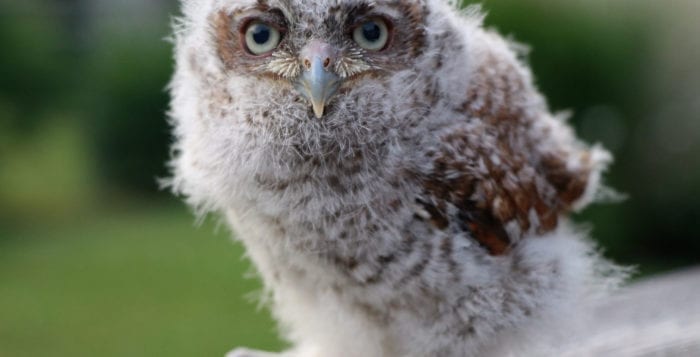
By Erica Cirino
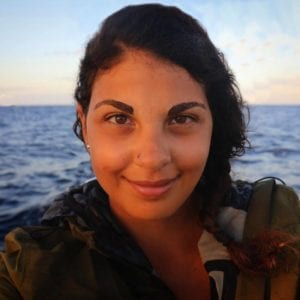
‘We are all fragments of the Earth’s collective imagination. From our perceptions of other beings and of places, we create ourselves. From our perceptions of ourselves, we create the meanings of our lives.’ — scrawled in my notes atop a cliff in Grimsey, Iceland, while watching a young puffin preen
The UN’s Global Assessment Report released on May 6 made something ecologists have been saying for years and years even more clear: Earth has an invasive species problem, and that is humanity. We are taking over land, sea, air and space at an unprecedented pace, and with painful consequences for all other life on this planet we share with eight million other species.
One million of these other eight million species are directly threatened with extinction due to our ravenous consumption of “resources” — the living and nonliving components of the Earth we choose to exploit — in addition to our straight-up takeover of space. Nonhumans probably classify us as a scourge. Rightly so.
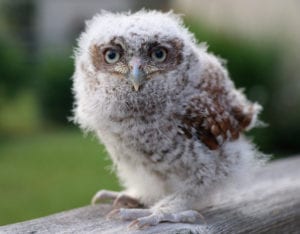
More than 7.3 billion humans are alive today. Less than 80 pygmy three-toed sloths are left in Panama as humans clear mangroves — sloths’ habitat — for farming. There are probably fewer than 10 tiny porpoises called vaquitas alive in the Gulf of Cortez today because humans have been illegally hunting a fish called a totoaba with gillnets that catch and kill nontargeted marine mammals, including vaquitas.
The world’s last northern white rhino died in Sudan in 2018 after a surge of poaching for rhino horn wiped out the entire species. Insects — which, while they can be pesky when buzzing in our ears or landing on our food — serve as part of the foundation of both terrestrial and aquatic food chains and pollinate the plants we rely on for survival but are dying off due to our intensive use of pesticides.
The seas are being emptied of fish to feed our growing, and increasingly hungry, human population as tiny and toxic particles of plastic increasingly permeate the marine food chain. The skies are emptying of birds, which are increasingly growing disoriented and crashing into buildings in our brightly lit cities filled with tall skyscrapers. Nonhuman terrestrial animals are being forced to live in shrinking habitats as we clear land, head for higher latitudes thanks to climate change, and off the coasts where rising seas encroach.
Yet, humans continue to take over the world. I find this fact quite difficult to cope with.
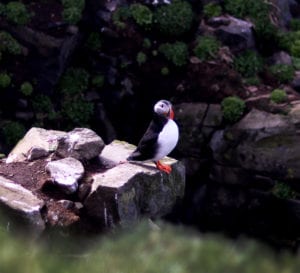
I am a licensed wildlife rehabilitator who has worked with sick, injured and orphaned nonhumans for more than 11 years, since the age of 15. I believe wildlife rehabilitation is not a solution to conservation issues, but simply a way to help individual nonhumans get a second chance at life, because humans have made life on this planet very hard for other species (and also our own species). It’s a small way to help right some of humanity’s wrongs.
But when I turned 22, frustrated by all the human-injured wildlife that passed through my hands (shot by BB guns, poisoned, abducted, abused, hit by cars, smashed into windows), I stopped working in the clinical setting and moved to the world of photojournalism. It was my attempt to enlighten humans to the plight of nonhumans — to offer facts, to help our species perspectivize and perhaps empathize — so that maybe some nonhumans would be spared from a destiny of harm instead of needing a rehabilitator’s help. I continue to rehabilitate a few nonhumans every year, because I empathize with them, I know about their natural lives, and I know how to give them first aid.
While humans are more than surviving on Earth, we are not exactly thriving: About one in 10 people in the world do not have enough food to live a healthy life. More than 300 million people in the world — including children — are depressed. Climate change is stressing the landscapes people rely on to survive, fueling disease, malnourishment, conflict and migration. If all of this sounds really horrifying, well, it is. But if you think we have it hard, try to imagine how the nonhuman animals must feel, with their world being taken over by just one species: us.
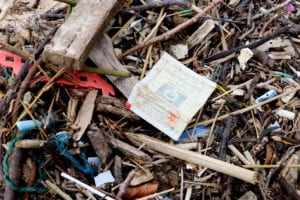
Animals must reproduce to survive. But humans have already proven that they can do that. Why do we reproduce more than we need to to hack it as a species? A lack of empathy? Pride? Is it something that happens when a human being is so full of confidence about oneself that they believe they should make a reflection of it? Or perhaps it is something that happens when a human being desires the opportunity to live vicariously through a blank canvas that they themselves can paint, can create, to right the wrongs that their parents — or maybe their parents-parents — made when raising them.
It’s clear we lack empathy, not only for other species but for our own. We are so individually focused. Why have such a strong drive to procreate when the survival of our species in this world is easy, virtually guaranteed? Why not focus on elevating the lives of the less-fortunate humans, and less-fortunate nonhuman beings? Why not use the energy we spend procreating elsewhere, like volunteering to reforest the planet or pick up plastic trash or feed hungry people? Yes, giving birth may fulfill a human’s primal desire to create, but at what costs for the entire world?
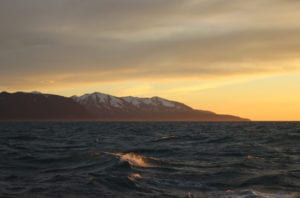
I have always wondered why we celebrate the birth of a human baby, but why there is no champagne and no cries of joy when the duckling hatches from an egg, when the she wolf delivers her pups, when a neonatal shark swims from a pouch. In raising and healing wildlife, I lay no claim. I try, in a very small way, to restore the proper balance of nature, rewilding the world by setting its nonhuman children free.
As a wildlife rehabilitator, I do not get congratulated each time I set an animal loose into the unforgiving arms of nature. I do not get cries of sympathy when an animal dies in my hands despite my attempts to resuscitate him or her. I do not get the same kind of pride out of raising a baby animal to adulthood as many people do when they raise a baby human. I don’t see a reflection of myself in the peeping owl hatchling or chattering baby squirrel, despite the fact I’ve spent painstaking days and nights, for weeks or months, feeding and cleaning these creatures.
And I don’t need to see that reflection. We are not all the same species, but I do feel that the wildlife and wild places of the world are a part of me. Though humans and nonhumans are separate in DNA, I believe we are still equals as kin on this Earth. We must get out of our own heads to empathize with nonhumans. We must prioritize the raising of all species, not just our own.
Erica Cirino is an international science writer, artist, award-winning photographer and licensed wildlife rehabber. Visit her website at www.ericacirino.com/speaking for a list of free upcoming lectures in Suffolk County.
All photos by Erica Cirino
EMERGING GREEN
Port Jefferson’s Parking Administrator Kevin Wood captured the beauty of the maritime village perfectly with this photo taken at Centennial Park on the morning of April 28. He writes, ‘As I was getting my dog Kismet out for a walk, this angle just caught my eye.’
Send your Photo of the Week to [email protected]
A score of people from Port Jefferson and surrounding areas gathered in front of Village Hall May 8 to protest what they said is a potential mass slaughter of innocent deer.
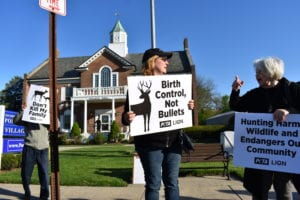
“Hunting tears families apart and leaves countless orphaned … they grieve for them, just like humans do,” said Gabby Luongo, a protest organizer and representative of animal rights group Long Island Orchestrating for Nature. “Trying to manage the deer through lethal means is also inefficient. When deer are killed, more deer will use those available resources, the temporary availability in the food supply will cause those does to breed at an accelerated rate.”
The protesters traveled from nearby areas like Shoreham, Selden and Fort Salonga as well as a few from the villages of Port Jeff and Belle Terre. They said they came in response to news the village has been making plans for some sort of deer management program, particularly some kind of controlled hunt or professional culling.
The protest signs read, “Don’t kill my family” and “Port Jeff: Animals are not ours to slaughter.” The signs also had the LION and People for the Ethical Treatment of Animals logos printed on them.
In April, the Village of Port Jefferson hosted a public forum with representatives from the New York Department of Environmental Conservation, along with other federal environmental agencies. Those representatives said deer have had a particularly harmful effect on the Long Island environment, especially in them eating vegetation and ground cover, including tree saplings that would replace the ever-shrinking forest growth of Long Island.
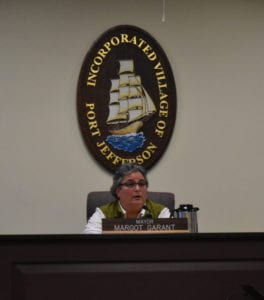
Village code still curtails hunting by restricting the use of any firearm or bow and arrow within village limits. However, Mayor Margot Garant said they have received a letter from the New York State Attorney General, Letitia James (D), stating the village does not have the legal capability to regulate hunting, as that is a state matter.
“The community has a lot to think about and address, the board of trustees has a decision to make, whether we change the code or keep the code in place and wait for that code to be challenged,” Garant said during the public portion of the meeting, attended by the protesters. “We are not here supporting the hunting of deer.”
The mayor said that no decisions have yet been made on the issue of deer population, and at the meeting left it open to any forms of suggestions, saying for the moment, the code restricting hunting remains on the books.
However, in conversation after the April deer forum, the mayor said if a person had the right permits and brought a hunter onto their property, and the hunter was staying a lawful distance from other residents property, the village could not and would not go after those residents who broke the code.
“I think we have to take a really hard look at what we’re doing, not just with deer, but all the other animals that pay the hard price for our greed and our non-consideration of them,” Shoreham resident Madeleine Gamache said.

Protesters at the meeting said instead of a hunt or cull, the village should instead look into nonlethal sterilization programs, such as that currently taking place in Head of the Harbor with the Avalon Park & Preserve. Scientists from Tufts University and The Humane Society of the United States have taken a $248,290 grant from the park to fund the six-year study.
“We would like to see some kind of birth control,” said Belle Terre resident Yvonne Kravitz. “We’re very much opposed to having these beautiful animals hunted and killed.”
Others called for the village to change the code to allow for higher fencing, as current fencing is restricted to no more than 6 feet.
Still, others were adamant the village needs to step up and perform a culling or controlled hunt of deer.
“I don’t know one person from where I live who doesn’t want you to go out and do a big cull,” said Port Jeff resident Molly Mason.
Garant said the village had a meeting with the Village of Belle Terre May 7, and the two villages together barely make up more than 4 square miles. A healthy deer population would be 15 deer per square mile but the local mayors have said the real number could be several hundred per square mile. Belle Terre has had 33 vehicle collisions with deer on Cliff Road alone, according to the Port Jeff mayor.
The Village of Belle Terre voted at the beginning of this year to allow hunting within the village. Since then Mayor Bob Sandak said hunters have killed approximately 100 deer so far.
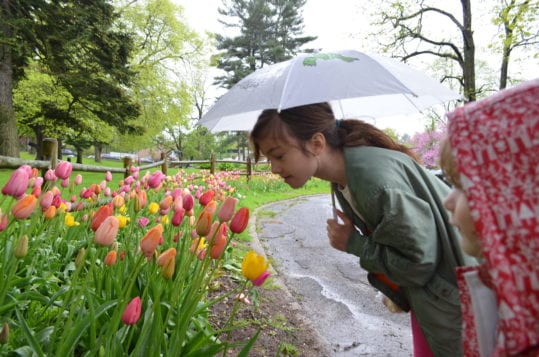
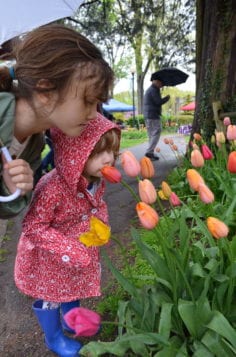
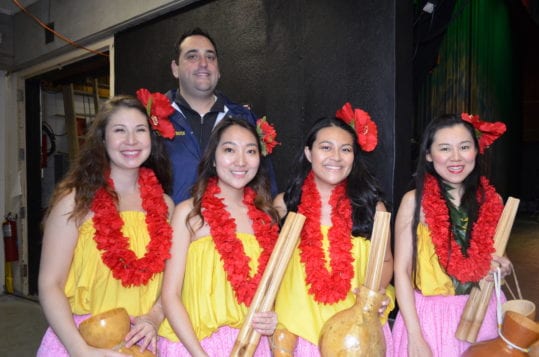
Gray skies set the scene for a burst of colorful tulips May 5 in Heckscher Park during the Town of Huntington’s 19th annual tulip festival. More than 20,000 tulips were planted for the event which featured crafts, vendors, music, dance and an art contest.
Learn the importance and fragility of a wetlands ecosystem, enjoy the beauty of a salt marsh moraine and be amazed at the untouched beauty of Long Island’s North Shore this summer aboard the Discovery Wetlands Cruises beginning May 16.
The Ward Melville Heritage Organization has been offering wetlands cruises since 1995 aboard its 27-passenger pontoon boat, carrying guests from the calm waters of Stony Brook Harbor into the wetlands at West Meadow Creek.
A naturalist is on board to guide passengers through this exceptional experience embracing ecology, geology and history, including information on how Native Americans first settled in the area. Adventurers and sightseers are encouraged to bring their binoculars for a close-up view of plant and animal life and their cameras to preserve cruise memories. Special Photography Cruises are also offered on board with an expert from Camera Concepts & Telescope Solutions discussing techniques to capture the best landscape and wildlife images on the water.
Cruises leave from Stony Brook Marine Services parking lot at 51 Shore Road in Stony Brook, across from The Three Village Inn, and run through Oct. 31. Individual rates are $28 for adults, $25 for students and seniors and $18 for children under 6. Photography cruises are $50 per person. Reservations are suggested to secure your spot but walk-ons are accepted, with cash payment at the boat, when space is available. For additional information or to make a reservation, call 631-751-2244 or visit www.wmho.org.
By John Turner
One of the great joys of living in the Three Village area are the plethora of parks and preserves to be explored and enjoyed. These public spaces, true community assets, include the Frank Melville Memorial Park/Three Village Garden Club complex and Lee Koppelman Nature Preserve in Setauket; Patriots Hollow State Forest in East Setauket; and Forsythe Meadows County Park, the Town of Brookhaven’s West Meadow Beach, and the rambling, privately owned Avalon Preserve in Stony Brook.
We can now add another public property to the list to be savored: the small (7 acres) but beautiful state-owned property at the entrance to Strongs Neck. Offering commanding views of the eastern shore of Conscience Bay, it was purchased on our behalf by the NYS Department of Environmental Conservation last summer.
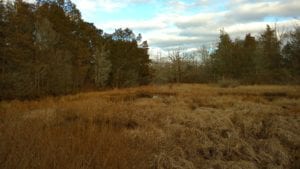
The entrance to the preserve is through a split rail fence along North Road. Here you’ll see the rock placed to recognize the contribution of the Besunder family who sold the property to the state. The trail passes by the plaqued rock and a small coastal salt pond on the right that is connected to the bay through a series of ditches in the salt marsh. Here I recently watched a great blue heron hunt for fish with zen-like patience, remaining perfectly still for minutes on end, lest it give away its presence due to some detectable movement.
The red cedars, along with pitch pine, the two more common coniferous trees native to Long Island, form thick stands throughout the property, growing in areas that are a few feet above the elevations of the surrounding marshland and only a few more feet above the high tide levels of Conscience Bay.
Thinking about the low-lying condition of this coastal forest caused a strong feeling of melancholy to usher over me, for I knew this forest, consisting of many hundreds of trees, will not likely survive more than two or three decades more. The cause for its ultimate demise? Elevated coastal waters due to sea level rise fueled by global warming.
In New York, sea levels are projected to rise, under the most optimistic conditions, 8 inches by the 2050s and, if the worse occurs, by 30 inches in the same period. Since 1900 they have already risen a foot due to the warming of ocean water with 8 inches of this rise having occurred over the past 50 years, indicating this rise is accelerating.
Given these projections, it is a certainty the property will lose its forests and very likely evolve into a salt marsh or into open water if the sea levels continue to rise. If this happens Strongs Neck will become “Strongs Island” and dozens of homes and businesses in the Three Village area will no longer be inhabitable.
The culprit for this unwanted change? Our stubborn refusal to enact the needed policies to limit carbon emissions by the amounts necessary and at a pace that’s rapid enough and a refusal colored by some “leaders” who still throw out the canard that global climate change is a myth.
Well, the best science is telling us that this “myth” is an incontrovertible “reality wall” that we will, with certainty, drive into with devastating consequences for us humans and the other living forms that share our planet — if we do not, very soon, begin to change course.
Soon I came out to the shore and my spirits brightened considerably, bathed as I was in this beautiful coastal scene of a gentle and sheltered harbor. Small wavelets lapped on the shoreline. Plus, seeing birds always helps the mood.
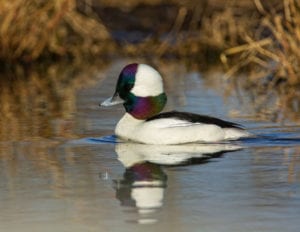
Along a distant shoreline a snow white American egret flew along, presumably heading to or from a feeding episode, and 150 yards from where I stood on the shore was a loose flock of buffleheads, a duck that is the definition of cuteness. The males are distinctive with their uniquely patterned heads — heads dominated by a white patch such that, if the duck’s head was a clock face, it would be white from 9 to 11 o’clock. The rest of the “clock” is dark and flashes iridescence from green to purple depending on the angle to the sun.
Flocks of buffleheads often dive synchronously leading to a “now-you-see-them, now-you-don’t” phenomenon as they dive below the surface to feed, before bobbing like released corks back to the surface. Where there were no ducks two seconds before, suddenly half a dozen are floating on the surface together.
Small as ducks go, their heads are large and that explains their common name. They were once called buffaloheads — shortened to buffleheads — since their heads were disproportionately large, just like the American buffalo (more accurately the American bison).
Buffleheads grace our coastal waters during the winter months.
As I walked out of the preserve and past the rock, I read the plaque and under my breath said, “Kudos to the Besunder family for committing to conservation and to the DEC for helping them to fulfill that commitment.” The images of buffleheads disappearing and re-emerging in the frigid waters of Conscience Bay, cavorting unconcerned about the elements, snug as they are in their feathered garb, stayed with me for the ride home.
A resident of Setauket, John Turner is conservation chair of the Four Harbors Audubon Society, author of “Exploring the Other Island: A Seasonal Nature Guide to Long Island” and president of Alula Birding & Natural History Tours.
By Richard Gass
On April 7, I discovered a baby great horned owl that had fallen from its nest in Miller Place.
After contacting New York State Department of Environmental Conservation, I was told to check on it the next day. On April 8, the owl was still there and looked very weak. I contacted the DEC and they put me in touch with the Save the Animals Rescue Foundation, a Middle Island wildlife nonprofit that helps rehabilitate injured animals.
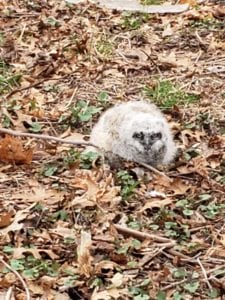
They recommended I bring the owlet to them to evaluate, and that it should later be returned to the nest, but an arborist would be needed with a bucket truck. I brought the owlet to Lori Ketcham, the director at the foundation, who determined it was dehydrated and hungry. They stabilized it.
“The owl was cold, and had been flat out on the ground,” Ketcham said. “The moms aren’t able to pick their babies off the ground.”
I contacted Dan Goodman, one of the owners of Lucas Shaun Tree Service. He arranged for a bucket truck at no charge and returned the owl to the nest with volunteer John Picerno from STAR. The owl is back in the nest with two other owlets and the parents are relaxed and caring for their family.
The owls are doing well and growing quickly.
To contact the STAR foundation, either call 631-736-8207 or email at [email protected]. Those interested can visit the website at www.savetheanimalsrescue.org if they wish to donate.
Richard Gass is a Miller Place resident.
Additional reporting by Kyle Barr
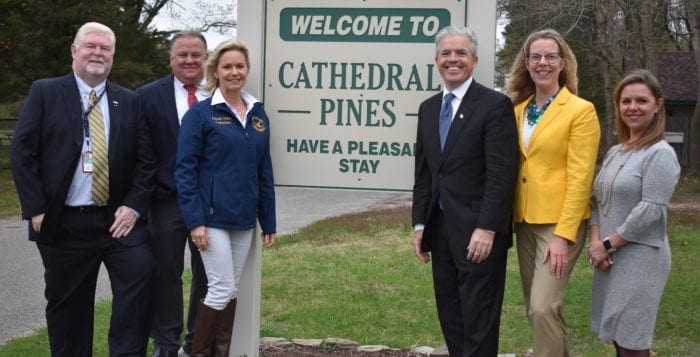
As the weather begins to improve and with summer just around the corner, residents may begin to enjoy Suffolk County-owned parks. With their minds on attracting nature tourism, county officials came together April 26 to announce the start of a $5 million multiyear modernization project at Cathedral Pines County Park in Middle Island.
“We are announcing our next phase of the Stay Suffolk campaign, where we are encouraging our residents to stay local,” County Executive Steve Bellone (D) said. “We want them to enjoy the things that we have here particularly in the summertime.”
The renovation project is part of an effort to promote Suffolk County parks, local tourism and highlight popular destinations, as well as regional attractions.
The first phase of the project will be a restoration of some of the park’s most used areas. Roads will be widened and realigned to reduce congestion, while areas are planned to be reconfigured to accommodate 74 additional campsites. All sites will be outfitted with concrete paved picnic table pads, barbecue grills, fire rings, a Wi-Fi system, water and electricity.
Additionally, the renovations will create a designated recreation area away from the current campsites in the center of the park, where visitors can have oversight over children without disturbing other campers.
“When we invest in our parks, it improves our quality of life,” Legislator Kara Hahn (D-Setauket), the chair of the Legislature’s parks committee, said.
“This is the place to be, and it will be even nicer once we are done with the improvement plan.”
— Kara Hahn
In 2012, the county had an analysis and study done on the park to develop a master plan, which has led to the $5 million expansion.
A playground will be converted into additional visitor parking, while the county would create a new children’s playground located adjacent to the activity building. New projects also include a new picnic pavilion area, additional picnic tables and grills, bathhouses with upgraded showers that meet Americans with Disabilities Act standards for accessibility, five new horseshoe courts, two new boccie courts and a new sand volleyball court. The final phase of the plan is to create a new drive-up check-in station for campers to streamline the check-in process and updates to sanitary systems and the installation of a new central dump station with tanks to store sanitary waste from the bathhouses.
Hahn added that the project will go a long way in providing the necessary activities for residents to take a vacation locally.
“There are so many spectacular spots available for hiking, camping and biking,” she said. “This is the place to be, and it will be even nicer once we are done with the improvement plan.”
Cathedral Pines consist of 320 acres of parkland located along the headwaters of the Carmans River and is one of 10 Suffolk County parks that offer overnight camping and possesses a 6-mile mountain bike trail system.
The county has also announced new accessibility options at other county-owned parks.
Handicap-accessible golf carts will be available at West Sayville Golf Course for free for disabled veterans. Wheelchair-accessible beach chairs will be available at the Cupsogue, Meschutt and Smith Point beaches. Patrons can call the beaches in advance to have the wheelchairs ready upon their arrival. Mobility mats will be rolled out this summer at Smith Point to make it accessible for wheelchair users, elderly and families traveling with children.
“I’m a part of the senior committee and I hear a lot of complaints that some residents are not able to come to our parks because it’s not accessible,” Legislator Sarah Anker (D-Mount Sinai) said. “So now moving forward we are investing in this very important issue.”
